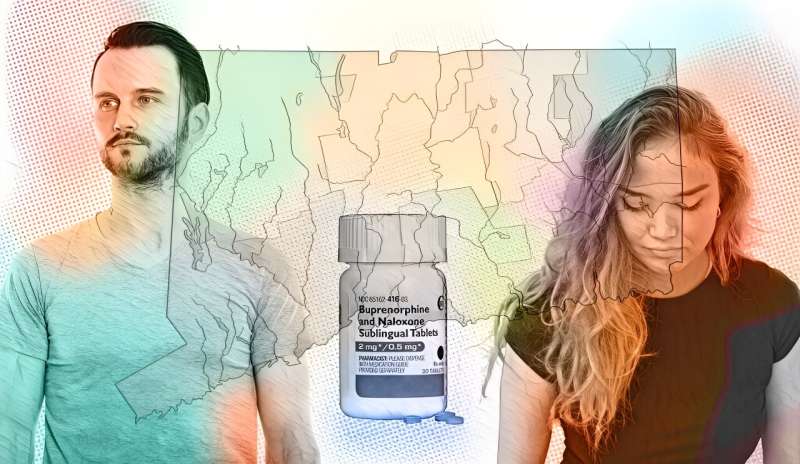This article has been reviewed according to Science X's editorial process and policies. Editors have highlighted the following attributes while ensuring the content's credibility:
fact-checked
peer-reviewed publication
trusted source
proofread
Treating opioid disorder without meds is more harmful than no treatment at all, finds study

In cases of opioid use disorder, short-term medically managed withdrawal (commonly known as detox) and long-term rehabilitation treatments that don't incorporate continued use of buprenorphine or methadone are no more effective at preventing overdose deaths than no treatment at all, a new Yale-led study reveals.
The findings, the researchers say, emphasize the importance of ongoing medication treatment for opioid use disorder and should inform how opioid settlement funds earmarked for addressing the crisis are spent.
The study was published in the journal Drug and Alcohol Dependence.
The opioid crisis has affected millions of Americans. Between 2012 and 2021, more than 650,000 people in the United States died from drug overdoses and the percentage of those deaths involving opioids increased from 56% to 75%, according to the Centers for Disease Control and Prevention. In every year but one during that period, deaths increased over the prior year such that the total increase was 157%.
Among the common treatment options for opioid use disorder are medications and abstinence-based programs. The medications buprenorphine and methadone, specifically, prevent health-threatening withdrawal symptoms and quell cravings, reducing the desire for illicit opioids. Abstinence-based programs include shorter-term medically managed withdrawal programs and longer, often month-long rehabilitation programs.
While previous research studies have compared the effectiveness of these two treatment categories in preventing the resumption of illicit drug use, as well as opioid overdoses and death, they have not compared how these two options fare against no treatment at all.
For the new study, Yale researchers assessed how many of the Connecticut residents who died from opioid poisoning in 2017 had sought medications, abstinence-based treatment, or no treatment for opioid use disorder at any point in the six months prior to their deaths. The researchers also estimated how many people in Connecticut had untreated opioid use disorder, which they based on recent national estimates, and gathered de-identified data on how many state residents received the different treatments during the same period.
The data was provided by the Connecticut Office of the Chief Medical Examiner, the Connecticut Department of Mental Health and Addiction Services, and the Connecticut Department of Consumer Protection.
In 2017, there were 965 accidental or undetermined poisoning deaths in Connecticut in which at least one opioid was detected. Of those, 69 people had been prescribed methadone in the six months before their death, 72 had received buprenorphine, 71 underwent short-term, non-medication-based treatments, 26 had attended longer-term, non-medication-based treatment programs, and 711 received no treatment at all. There was a small number of individuals whose treatment exposure was unclear.
When the researchers calculated the risk of fatal overdose death for each treatment, they found that compared with no treatment at all, methadone and buprenorphine reduced the risk of death by 38% and 34%, respectively.
"However, non-medication-based treatments increased the risk of death compared to no treatment by over 77%," said Robert Heimer, professor of epidemiology at Yale School of Public Health and lead author of the study. "There are plenty of studies that show medication-based treatment is better than abstinence-based treatment. Now we can also say patients are no better off getting abstinence-based treatment compared to no treatment at all."
One reason abstinence-based treatment might lead to more fatal overdoses, Heimer said, is because when people stop using opioids throughout those treatment programs, they lose their tolerance to opioids. If they relapse, their lower tolerance makes them more susceptible to overdose.
On the other hand, buprenorphine and methadone work on the same receptors in the body that opioids like heroin and fentanyl do. If a person is taking one of these medications and relapses, he said, they won't have reduced opioid tolerance, making it far less likely that they will overdose.
"Access to medications saves lives and treatments without medications can in fact be harmful. We need to be loud and clear about this message to individuals with opioid use disorder and the community," said Gail D'Onofrio, the Albert E. Kent Professor of Emergency Medicine at Yale School of Medicine and co-author of the study.
Over the next 18 years, Connecticut will receive $600 million in opioid settlement funds paid by pharmaceutical companies that produced opioids, companies that distributed them wholesale, and pharmacy chains that sold them to patients. Heimer says that how those funds are used should be informed by their current findings, which—in agreement with prior research—demonstrates the superiority of methadone and buprenorphine over abstinence-based care.
"We can make decisions on how to spend the settlement funds based on what people want or based on what the evidence says people need," said Heimer.
Many people, including those with opioid use disorder, prefer abstinence-based treatments, but Heimer says that is, in part, a reflection on how stigmatized opioid use has become. Terms like "getting clean" and even "recovery" stigmatize use of proven medications, hindering willingness to receive effective treatment.
"I see 'recovery' as something you do if you have the flu or break a leg that are acute events," said Heimer. "I prefer 'remission,' which is a better way to think about any chronic disease, including substance use disorders. If you successfully manage the illness, you're in remission. If you don't, you've had a relapse or a recurrence. Methadone and buprenorphine reduce the risk of relapse and dying from an opioid overdose."
To keep people in remission and save lives, priority should be placed on getting those with problematic opioid use started on medications and helping them remain in treatment, he added.
More information: Robert Heimer et al, Receipt of opioid use disorder treatments prior to fatal overdoses and comparison to no treatment in Connecticut, 2016–17, Drug and Alcohol Dependence (2023). DOI: 10.1016/j.drugalcdep.2023.111040




















